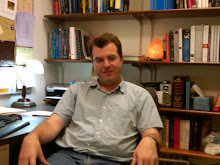Confession: I know next to nothing about general relativity. My graduate work was in materials and optics. My current research is mostly on optics and biophysics. I enjoy the elegance of special relativity, but I never studied general relativity.
In a couple weeks I'm teaching students about Newtonian mechanics in non-inertial reference frames, and I felt like I should try to learn at least a few tidbits of general relativity. I wanted to understand gravitational time dilation, so I came up with a nice little argument that I'm quite proud of.
Suppose that a pair of particles collide and produce two photons. One photon goes left, the other goes right. We use mirrors to send them upward (i.e. to a place to higher gravitational potential) and then recombine them. The photons collide and produce a pair of particles of the same type as the original particles. (Such things can happen, though the cross-sections are small.) If the photons did not change their frequencies, i.e. did not lose some energy, then we have a new pair of particles at higher gravitational potential energy but with the same kinetic energy. We have gained energy. We can let those particles fall and extract energy from the system to power machines...for free. We have thus produced energy from nothing, and that's not allowed.
The photons must thus lose some energy, i.e. must change their frequencies. Say that the kinetic energy of the new particles is zero, i.e. mgy(final)=KE(initial)
The frequency shift can be found via:
KE(initial) + 2m = 2*omega (initial) = 2m + 2mgy
And 2m must also equal 2*omega(final), since the two photons have just enough energy to produce the particles, so we get that 2*omega(initial) = 2*omega(final) + 2*omega(final)*gy
omega(final)*(1+gy) = omega(initial)
omega(final) = omega(initial)/(1+gy) or approximately omega(initial)*(1-gy) (to first order)
(We are working in units where hbar and c are equal to 1.)
So the fractional frequency shift has to be of order gy/c^2. Once we have the frequency shift, we can argue that clocks based on oscillations of EM fields must run slower lower in the gravitational field, since the people above them are receiving consecutive ticks at longer intervals.
I will present this at the end of my lecture on Newtonian mechanics in non-inertial frames, along with the argument that a guy in a falling elevator sees light curve.



No comments:
Post a Comment